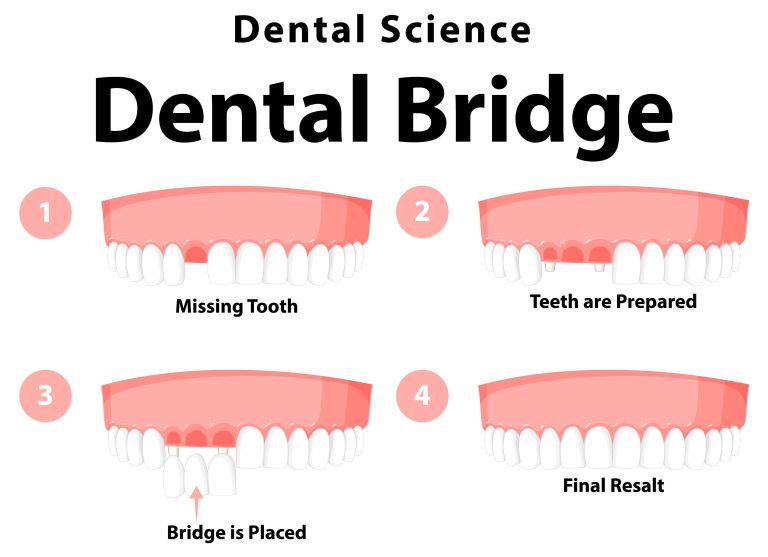Dental bridges are a common and effective solution in dental restoration, designed to replace one or more missing teeth. They literally “bridge” the gap created by missing teeth, using the surrounding teeth or dental implants as anchors. This not only restores the appearance of a full set of teeth but also helps maintain the proper alignment and function of your bite. By properly distributing the forces in your bite, dental bridges can prevent other teeth from shifting out of position, leading to further dental issues. This article will explore the different types of dental bridges available, their specific uses, and their benefits in maintaining oral health and enhancing your smile.
A traditional dental bridge is a common dental restoration that replaces one or more missing teeth. This type of bridge consists of a false tooth or teeth, known as pontics, held in place by dental crowns cemented onto the adjacent teeth, called abutment teeth.
The process of anchoring a traditional dental bridge involves several steps:

A cantilever tooth bridge is a type of dental restoration designed to replace missing teeth. Similar to traditional bridges, it features a unique design. Unlike traditional bridges, which are anchored to two adjacent teeth, a cantilever tooth bridge is anchored to only one adjacent tooth. This makes it a suitable option in specific situations where there are teeth only on one side of the gap.
Cantilever bridges are typically used when only one natural tooth is available to support the bridge. This is often the case in areas of the mouth where less stress is placed on the teeth, such as the front teeth. They are not usually recommended for the back teeth (molars) because these teeth endure significant chewing forces, which could potentially cause the bridge to fail.
Advantages and Considerations:
A Maryland or resin-bonded dental bridge is a conservative and minimally invasive option for replacing missing tooth. Unlike traditional bridges, which require crowns on the adjacent teeth, Maryland bridges use a different attachment method that preserves more of the natural tooth structure.
Maryland bridges often replace front teeth where the forces of biting and chewing are less intense. They suit patients with healthy adjacent teeth and good oral hygiene. This type of bridge is ideal for:
Advantages and Considerations:
An implant-supported dental bridge is a highly durable and stable option for replacing missing teeth. Unlike traditional bridges that rely on adjacent natural teeth for support, implant-supported bridges are anchored directly into the jawbone using dental implants, providing a strong and long-lasting foundation.
Implant-supported bridges are ideal for patients missing multiple teeth in a row and have sufficient jawbone density to support the implants. They are particularly beneficial for:
Advantages and Considerations:

Several factors must be considered when choosing the right dental bridge, including safety, cost-effectiveness, durability, and weight. Here’s a detailed comparison to help you understand which type of dental bridge might be best for your needs.
The safest type of dental bridge largely depends on the individual patient’s oral health and specific needs. However, implant-supported bridges are often considered the safest option because they do not rely on adjacent teeth for support. Instead, they are anchored directly into the jawbone using dental implants, which help preserve the integrity of the surrounding teeth and maintain jawbone health. This method reduces the risk of damage to natural teeth and provides a stable and secure foundation for the bridge.
Traditional dental bridges are generally the most cost-effective option upfront. They involve placing crowns on the adjacent teeth to support the pontic (false tooth), which typically costs less than implant-supported bridges. However, it’s important to consider long-term costs, as traditional bridges may require more frequent replacements or repairs than implant-supported bridges.
Implant-supported bridges are the most durable type of dental bridge. They are anchored directly into the jawbone, providing a strong and stable foundation that can last many years, often decades, with proper care. The implants are made from titanium, a highly durable material that integrates well with the bone, ensuring long-term stability and function.
Maryland or resin-bonded bridges are typically the lightest when considering the weight of the bridge. These bridges use metal or porcelain wings bonded to the back of adjacent teeth, requiring less material and making them lighter than traditional or implant-supported bridges. This can be particularly beneficial for patients who prefer a less invasive and lighter option for their dental restoration.
Choosing the right dental bridge is an important decision that can significantly impact your oral health and quality of life. Consulting with a dentist at Hello Dental ensures you receive the best possible care and achieve a healthy, beautiful smile.
Copyright © 2024 Hello Dental Clinic. All Right Reserved.
475, Jalan Sultan Azlan Shah,
Taman Million,
51200 Kuala Lumpur
Mon-Fri: 09:00-19:00
Sat-Sun: 09:00-17:00
V06-02-05, Signature Retail Lot,
Sunway Velocity,
Lingkaran SV, Jalan Shelley,
55100 Cheras KL
Mon-Fri: 09:30-21:00
Sat-Sun: 09:00-18:00
2-02, Level 2, Wisma Conlay,
No.1, Jalan USJ 10/1,
Taipan Business Centre,
47620 Subang Jaya, Selangor
Mon, Tue, Fri: 10:00-18:30
Wed, Thu: 10:00-21:00
Sat, Sun: 09:00-15:30
G-8, Idaman Robertson,
No. 2, Jalan Robertson,
50150, Kuala Lumpur.
Mon, Thur: 11:00-20:00
Tue, Wed, Fri: 09:30-21:00
Sat, Sun: 10:00-19:00
No. 2-2 (Second Floor),
Jalan Solaris 5,
Solaris Mont Kiara,
50480 Kuala Lumpur
Mon-Fri: 10:00-19:00
Sat-Sun: 10:00-18:00